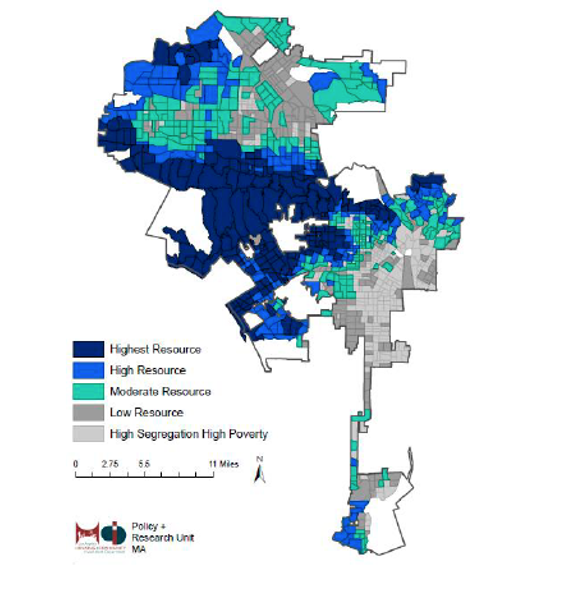CommentsPLANNING WATCH-PT Barnum said there is a sucker born every minute. Famous newspaper man, H.L. Mencken wrote something similar, “No one nobody ever went broke underestimating the intelligence of the American people.”
Too bad these famous truth-tellers are no longer around to pull back the curtain on another whopper, that giving real estate investors free rein through up-zoning results in economic and racial equity.
This story begins with the enormous Black Lives Matter (BLM) demonstrations in the summer of 2020. There were spontaneous BLM rallies in all 50 states protesting the murder of George Floyd. Some news stories reported that this was the biggest wave of demonstrations in American history, and it was certainly the largest protest movement since the Occupy Wall Street encampments of 2008.
Shortly after the BLM marches, the non-profit, public, and private sectors responded with programs to promote racial equity, (not to be confused with structural changes achieved by a wealth tax and increased minimum wage.) In the lead were the social justice foundations, especially the Ford Foundation. In July 2020 it declared that local programs that promoted racial equity in American cities were its priority, even though the BLM demonstrations’ focus was police murders, not housing discrimination.
The private sector soon followed suit, such as Citi Bank. It created a $1 billion fund to narrow the racial income gap.
Another part of the story is the role of advocacy organizations. In an August 2020 position paper on racial disparities and housing policy, Habitat for Humanity International wrote, “Helpful reforms can take various forms, including lowering minimum home-size and lot-size requirements, permitting duplexes and triplexes, allowing apartments in more locations, and minimizing discretionary review processes.”
At the same time, the media offered parallel stories, such as a July 2020 article in Forbes Magazine on housing equity, How Systematic Racism Exists in U.S. Housing Policy. The article’s theme was a straightforward call for up-zoning, “Zoning laws rooted in racist land-use policies continue to . . . limit the amount of multifamily housing that can be built in certain neighborhoods.”
How have elected and appointed officials responded to these and similar public policy overtures from the real influencers in American society?
President Biden has offered equity as the rationale for the housing component of his American Jobs bill. It would offer housing grants to cities that increased their zoning capacity, a supposed step to reduce racial disparities.
At the State level, the California Housing and Community Development Department has issued detailed maps for the entire state identifying opportunity areas where up-zoning should be encouraged to, they claim, promote racial equity.
The same message gushes forth from up-zoning advocacy groups in LA, which conflate racial equity with private sector housing investment. They, too, quickly hopped on board, claiming zoning deregulation would eliminate racial inequality.
Not to be outdone, a group of liberal academics have issued a detailed call for President Biden’s American Jobs Plan’s proposal. They want to heavily condition the proposed legislation’s neo-liberal up-zoning component, so it promotes racial equity, not developer profits.
At the local level, on June 10, 2020, Mayor Garcetti created a Racial Equity Task Force. It quickly led to the appointment of Racial Equity Officers and creation of Racial Equity Action Plans in City Hall’s many Departments and Offices. These actions were accompanied by a new City agency, the Department of Civil + Human Rights and Equity. It is still difficult to determine if the Mayor’s initiatives were theater because one year later the City’s official website has little information about the Racial Equity Task Force and new Department.
Nevertheless, some City Hall officials got the message about racial equity. City Planning recently issued a lengthy report to the City Council on the citywide distribution of equitable affordable housing. This report portrayed up-zoning as a major equity program. While giveaways to real estate developers have been standard City Hall practice for decades, the claim that these sweetheart deals are bold steps toward economic and racial equity remains evidence-free.
These are the report’s major proposals to promote equity through the planning process. (Since the abridged bullet points below are extracted from the City Planning report, I encourage CityWatchLA readers to check out the full text.)
-
Use the Community Plan Update and Housing Element planning processes to establish a fair share distribution of affordable housing based on SCAG’s Regional Housing Need Assessment (RHNA) allocations.
-
Develop new mechanisms to meet the identified affordable housing needs in each Community Plan area.
-
Create a Housing Element Rezoning Program that focuses a majority of the additional capacity in high opportunity areas with good access to jobs and/or transit.
-
Update LA’s Housing Element to emphasize the equitable distribution of affordable housing in high opportunity areas.
-
Devise a housing needs assessment methodology to allocate citywide housing targets to Community Plan areas based on racial and economic segregation.
-
Consider a Housing Element Rezoning Program that focuses on high opportunity and moderate resource areas. Rezoning should target commercial corridors, existing and new regional centers, public land, and parking (P) zones.
-
Examine up-zoning and related incentives for existing single-family or lower density areas to create opportunities for “missing middle” housing in higher opportunity areas.
Since this report is not transparent, let me translate it into accessible English. It is nothing more than Reaganomics. Los Angeles should up-zone affluent neighborhoods, as shown in the map below. They will become the location of most future residential construction, including affordable housing units for low-income Angelinos. In these areas up-zoning will allow developers to automatically build taller, larger, denser (more units per lot) profitable buildings without zoning waivers.

Figure 3. 2019 TCAC/HCD Opportunity Area Map, City of Los Angeles
Will this report’s recommendations work? Will up-zoning LA’s “high opportunity” neighborhoods tracts on the above map (black, blue, and turquoise) produce affordable housing and a more equitable Los Angeles?
The answer is NO. These are the reasons:
-
These neighborhoods have expensive land. If these parcels are up-zoned, their value will further increase. To obtain a competitive rate of return, about 15 -20 percent per year, developers will build the most profitable (i.e., expensive) houses or apartments possible, not unprofitable low-income units. This explains why LA has permitted so few low-income residential units since 2010, only 15,886 based on Planning’s report to the City Council.
-
This total only includes permitted low-income units, not those issued a Certificate of Occupancy and then rented to low-income tenants.
-
These proposals also ignore essential information.
-
LA’s transit-rich commercial corridors already have zoning that permits apartment houses. This untapped zoning vastly exceeds the RHNA allocation to Los Angeles that drives Planning’s report.
-
LA’s single-family parcels have already been up-zoned. In addition to the main house, they can have an Accessory Dwelling Unit (ADU) of 1200 square feet, a 500 square foot ADU in the primary dwelling, and a small house on wheels.
-
The report does not call for restoring the public housing programs that HUD jettisoned over the past half century. They would be an obvious source of funding for the construction of desperately needed low-priced housing.
-
The report fails to mention that increasing and indexing the wages of the over-crowded and the homeless would allow them to rent the thousands of vacant apartments that have appeared in Los Angeles neighborhoods during the past year.
-
The report pours old wine into new bottles. The War on Poverty of the 1960’s Johnson administration was premised on dispersing the poor (code for African Americans) to more affluent neighborhoods. It did not work because the transplants remained poor, and the new neighborhoods did not have the personal networks and social services they left behind.
The content of these racial equity proposals is trickle-down economics -- if we let the rich get richer through real estate investments, housing and economic opportunities will lift-up the poor. It did not work for Lyndon Johnson or Ronald Reagan, and it will not work this time either.
(Dick Platkin is a former Los Angeles city planner who reports on local planning issues for CityWatch. He serves on the board of United Neighborhoods for Los Angeles (UN4LA) and co-chairs the new Greater Fairfax Residents Association. Previous Planning Watch columns are available at the CityWatchLA archives. Please send questions and corrections to [email protected].)














